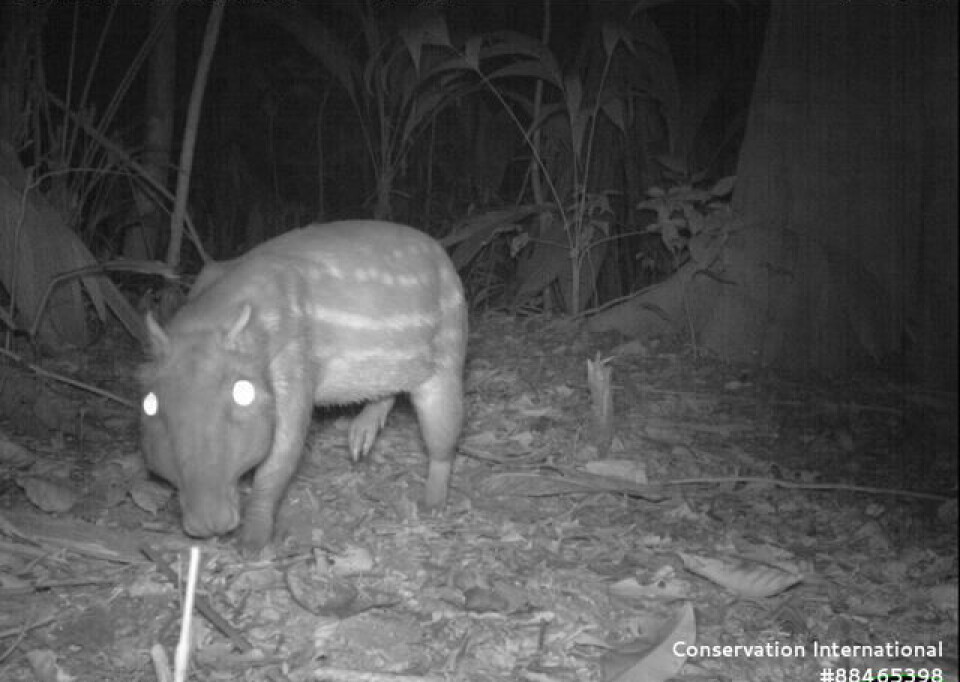THIS CONTENT IS BROUGHT TO YOU BY the Norwegian University of Life Sciences (NMBU) - read more

Beware of the full moon: Mammals in tropical forests shy away from moonlight
New research shows that half of the mammal species in tropical forests adjust their behaviours in response to the moon's phases. This can impact conservation efforts.
“Imagine playing hide-and-seek in a dark room, and then somebody lights a candle. The light, even if it's weak, may make it easier for you to find your way around the room. But if you're the one hiding, you suddenly become a lot easier to detect,” says Richard Bischof.

He is a professor at the Norwegian University of Life Sciences (NMBU).
Wildlife cameras
This is how extra light changes the conditions for predators and their prey inhabiting tropical forests. But in nature, the stakes are much higher.
The researchers have analysed images from automatic wildlife cameras across three continents. They have studied how the moon's phases affect the behaviour of tropical forest mammals.
Half of the species altered their activity levels, or timing, or both in response to the full moon.
The findings suggest that even in some of the darkest places on Earth - the floors of tropical forests - the moon's phases can influence animal behaviour. This impact could be even more pronounced in degraded and fragmented forests.
Half of the species altered their behaviour
An international team of researchers has analysed 2.1 million images from wildlife cameras from 17 protected forests on three continents.
The wildlife images have been collected by the Tropical Ecology Assessment and Monitoring (TEAM) Network.
In total, 86 mammal species were recorded. 12 species displayed strong avoidance of moonlight at night. Only 3 species exhibited a strong attraction to moonlight.

“These were the species with the most pronounced reactions. However, half of all species responded to lunar phases, either by changing their nocturnal habits, altering their overall activity levels, or both,” says Bischof.
Avoidance of the full moon was more common.
30 per cent of all species exhibited avoidance. 20 per cent of species showed attraction. Nocturnal species, especially rodents, were over-represented among species that avoided the full moon.
What is the problem?
But surely moonlight is a natural phenomenon? Why should we worry about how animals respond to it?
“The key takeaway from our research is that light affects animal behaviour. It raises further questions about how changes in illumination affect species activity,” says Bischof.
Other conditions that increase light levels on the forest floor include changes in canopy cover due to logging, and artificial illumination, such as road lights and buildings.

Tropical forests house a substantial portion of the Earth’s biodiversity. They are being cleared, fragmented, and degraded at an alarming rate. This results not only in direct habitat loss and modification but also in reduced canopy cover.
“Areas affected by artificial illumination due to urbanisation also continue to increase,” he says.
More light – less activity
Despite humanity’s massive impact on the globe, we still know remarkably little about the implications of illumination on the activity of most mammals.
The higher prevalence of avoidance of the moon in the study suggests there may be more losers than winners when illumination increases in tropical forests. Almost all species that responded negatively to moonlight did so at least in part by reducing their overall activity during periods with full moon.
“If these results extend to artificial light, loss of dark nights could curtail the amount of time animals invest into foraging and other important activities,” says Bischof.
He warns that there is a risk we are fundamentally altering both the composition of species and their interactions in tropical forest communities, and this is happening simply through changes in light conditions.
The influence of natural and artificial light raises important questions and concerns in wildlife conservation and ecosystem functioning.
Reference:
Bischof et al. 'The moon’s influence on the activity of tropical forest mammals', Proceedings of the Royal Society B, 2024. DOI: 10.1098/rspb.2024.0683 (Abstract)
More content from NMBU:
-
Shopping centres contribute to better health and quality of life
-
We're eating more cashew nuts – and the consequences are serious
-
Do young people with immigrant parents have better health?
-
Who’s picking your strawberries this summer?
-
Can coffee grounds and eggshells be turned into fuel?
-
Rising housing costs fuel inequality in Norway





































